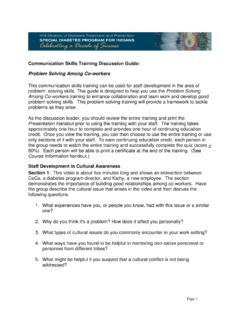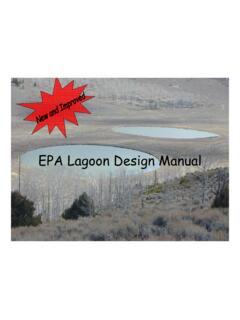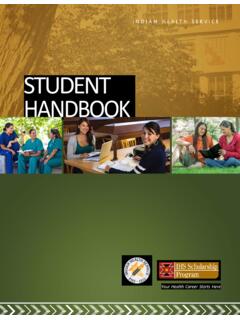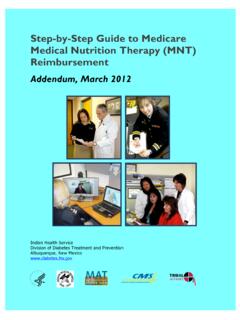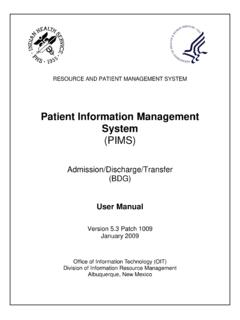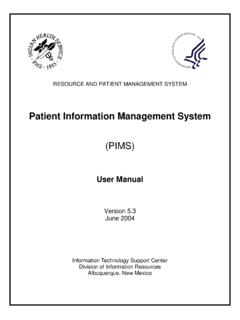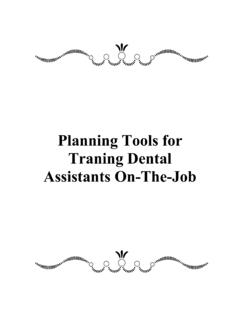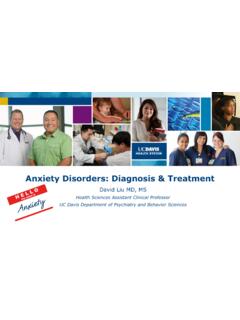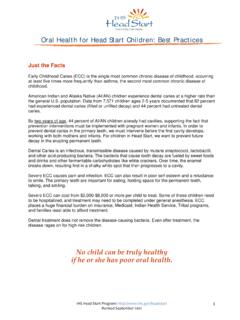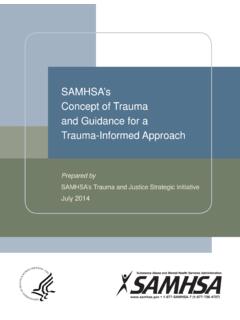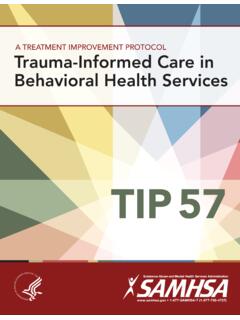Transcription of Seeking Safety A Treatment Program for PTSD and …
1 A C L I NICAL APPRO A CH TO WORKING. WITH SUBSTAN C E ABUSE AND ptsd . Seeking Safety A Treatment Program for ptsd and Substance Abuse A V I K R I E C H M A N, M. D. 2014. Seeking Safety is an evidenced based Treatment model that treats the co-occurring diagnosis's of ptsd and Substance Abuse Treatment focuses on both diagnoses Each condition is seen as adversely affecting the other This model creates a balance between exposure to dual Treatment issues while avoiding exposure to significant trauma memories Najavits, L. M., (2002) Seeking Safety A Treatment Manual for ptsd and Substance Abuse ptsd and Substance Abuse: A Patient's Perspective Seeking Safety As far back as I can remember someone was abusing me: my brother, my father, my distant mother. By the time I was 12, I was falling into abusive relationships with men, many who took advantage of a young desperate girl.
2 I had begun to treat myself as I had been treated, as unimportant outside of giving people what they wanted from me. To cope with the memories and repeated traumas, I was using drugs supplied by people who professed to love me.. Seeking Safety The more I use, the more I won't feel anything. The pain is so bad you just want to die. There is no other way out. If you talk about it, it will hurt too much. So instead, keep it a secret. No one will know.. Najavits, L. M., (2002) Seeking Safety A Treatment Manual for ptsd and Substance Abuse. New York: Guilford Seeking Safety Night time is the absolute worst. I worry about my friends who are still there. I. can't stand noise. I can't stand silence.. Defining ptsd 7. Post Traumatic Stress Disorder is the result of an event or series of events that were acutely damaging to the emotional, physical, and psychological well being of an individual.
3 -The traumatic experience would be defined as occurring out of the control of the traumatized individual -The traumatized individual could have witnessed or been directly involved in the event -The event outside of the individual's control would be experienced as a physical threat ( , physical/sexual abuse, war combat, seeing someone killed or abused, surviving catastrophic events such as a hurricane or car accident). Najavits, L. M., (2002) Seeking Safety A Treatment Manual for ptsd and Substance Abuse. New York: Guilford Responses Responses to the Traumatic Event: Involve intense helplessness, fear, or horror Children often exhibit agitation, disorganized functioning and problem behavior Najavits, L. M., Seeking Safety A Treatment Manual for ptsd and Substance Abuse. New York: Guilford Symptoms ptsd Symptoms: (symptoms persist for more than a month).
4 Intrusion: The trauma comes back into memory even with attempts to avoid thinking about the event(s). -flashbacks, nightmares, images Avoidance: Numbing, feeling detached, avoiding reminders of the trauma Arousal: Feeling hyped up . - startle response, hyper-vigilant, sleep disturbance, anger, crying Lowered functioning: Problems with relationships, work, or other major life areas Najavits, L. M., (2002) Seeking Safety A Treatment Manual for ptsd and Substance Abuse. New York: Guilford Types of ptsd . Simple ptsd . From a single incident (such as a car accident, or weather related catastrophe), usually as an adult Complex ptsd . Results from repeated incidents such as domestic violence, childhood abuse, combat tour of duty Najavits, L. M., (2002) Seeking Safety A Treatment Manual for ptsd and Substance Abuse. New York: Guilford ptsd Symptoms Self harm Numbness Suicide Loss of Faith Dissociation Loss of Trust Memory Health Sexuality Security Concerns Shame Anger Anxiety Guilt Feeling Damaged Najavits, L.
5 M., (2002) Seeking Safety A Treatment Manual for ptsd and Substance Abuse. New York: Guildford Statistics ptsd Prevalence Women 51% experience trauma , with 10%. developing ptsd . Men 61% experience trauma , with 5%. developing ptsd . Najavits, L. M., (2002) Seeking Safety A Treatment Manual for ptsd and Substance Abuse. New York: Guilford ptsd and Substance Abuse Cultural Issues In the US rates of ptsd do not differ by race (Kessler et al., 1995). In the US Hispanics and African Americans have lower substance abuse rates than Caucasians Native Americans have higher substance abuse rates than Caucasians. Najavits, L. M., (2002) Seeking Safety A Treatment Manual for ptsd and Substance Abuse. New York: Guilford Prevalence Prevalence of the dual diagnosis of ptsd and Substance Abuse Co-occurring diagnosis of ptsd and Substance Abuse in addiction Treatment facilities - 12% - 34%.
6 Women in substance Treatment 30% - 59%. Men in substance Treatment 11% - 38%. Typically ptsd symptoms preceded the onset of substance abuse. Najavits, L. M., (2002) Seeking Safety A Treatment Manual for ptsd and Substance Abuse. New York: Guilford ptsd Response Why do Some Individuals Exposed to trauma Develop ptsd and Others Do Not Much is unknown Personality may influence ptsd response Life situation during and after trauma event may contribute Quality of lifetime relationships Najavits, L. M., (2002) Seeking Safety A Treatment Manual for ptsd and Substance Abuse. New York: Guilford DSM-5 ptsd criteria trauma that is re-experienced, avoided, associated with symptoms of arousal/reactivity and associated with negative cognitions and mood - negative beliefs/expectations about self or the world - distorted blame of self/others for causing trauma or for resulting consequences - negative trauma -related emotions (fear, horror, anger, guilt, shame).
7 - feeling alienated from others - inability to experience positive emotions - diminished interest in pre-traumatic activities ptsd and Substance Abuse Links Between ptsd and Substance Abuse Two main themes of both disorders are secrecy and control Each of the disorders makes the other more likely Both diagnoses have higher rates of personality disorders ptsd symptoms widely reported to become worse with initial abstinence Both situations produce a profound need to be in an altered state Najavits, L. M., (2002) Seeking Safety A Treatment Manual for ptsd and Substance Abuse. New York: Guilford Treatment Issues In a study of 77 women with current ptsd and substance dependence most of the Treatment focused on substance abuse. 80% would choose to treat ptsd (either combined with substance abuse or alone). Fewer than 20% would choose substance abuse Treatment alone Najavits, L.
8 M., (2002) Seeking Safety A Treatment Manual for ptsd and Substance Abuse. New York: Guilford Current Treatment Needs Attention to Co-occurring Treatment Needs Most substance abuse(SA) patients are not sufficiently assessed for ptsd issues even after multiple addiction treatments Most SA patients are not informed of the ptsd diagnosis Most substance abuse facilities do not endorse co-occurring Treatment for SA and ptsd . Most mental health providers do not routinely screen ptsd . patients for substance abuse Najavits, L. M.,(2002) Seeking Safety A Treatment Manual for ptsd and Substance Abuse. New York: Guilford History of Treating ptsd . Knowledge About ptsd Relatively New First emerged in the study of soldiers returning from combat Later broader application to other types of abuse emerged 1980 ptsd added to the official list of psychiatric disorders Najavits, L.
9 M.,(2002) Seeking Safety A Treatment Manual for ptsd and Substance Abuse. New York: Guilford Model Lisa Najavits Seeking Safety Model Emphasizes importance of treating ptsd and substance abuse concurrently Establishes clear clinical guidelines for combining ptsd and substance abuse Treatment Utilizes homework and the practice of new behaviors Incorporates Cognitive Behavioral Therapy Najavits, L. M.,(2002) Seeking Safety A Treatment Manual for ptsd and Substance Abuse. New York: Guilford Lisa Najavits Model Encourages understanding of relationship between patient's ptsd trauma and substance abuse Emphasizes skill development and improved coping responses It is the first Treatment for ptsd and substance abuse with published outcome results (Najavits et al., 1997, 1998e). Najavits, L. M.,(2002) Seeking Safety A Treatment Manual for ptsd and Substance Abuse.
10 New York: Guilford Treatment Manual Treatment manual comprises: Psychotherapeutic Treatment approach for groups and individuals 25 topic areas addressing recovery and coping skills development Each of the 25 topic areas are evenly divided among cognitive, behavioral, and interpersonal domains Each topic area includes a Safety oriented skill relevant to both ptsd and substance abuse Each topic is independent of the others Najavits, L. M.,(2002) Seeking Safety A Treatment Manual for ptsd and Substance Abuse. New York: Guilford Treatment Topics: Seeking Safety Commitment Safety Creating Meaning ptsd : Taking Back Your Power Community Resources Detaching from Emotional Pain (Grounding) Setting Boundaries in Relationships When Substances Control You Discovery Asking for Help Getting Others to Support Your Recovery Taking Good Care of Yourself Coping with Triggers Compassion Respecting Your Time Red and Green Flags Healthy Relationships Honesty Self-Nurturing Recovery Thinking Healing from Anger Integrating the Split Self The Life Choices Game (Review).
